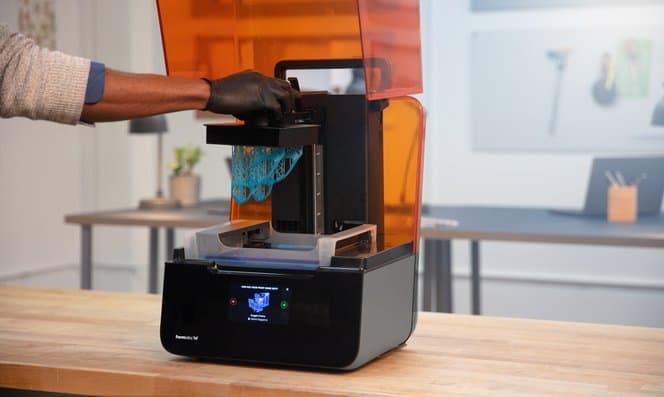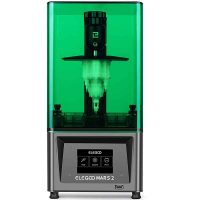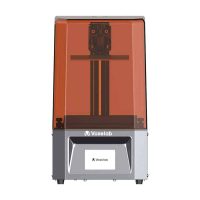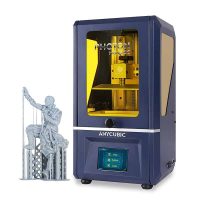Best Resin 3D Printer in 2021
Printing highly detailed models and shapes has never been more in reach
- Last Updated Jun 21, 2021

What is 3D printing?
Right, so you are here which I’m taking as you having an interest in 3D printing already. I’m also assuming (hopefully correctly) that you are no expert and either want to find out more or expand your existing knowledge.
3D printing is the process of making an object out of material. Just like “normal” printing takes a blank sheet of paper and turns it into a sheet of words, or a photograph or whatever, a 3D printer takes, well thin air, and eventually chucks out a 3D item – be it a model or whatever that you sent to it.
3D printing is the process of additive manufacturing which is a fancy way of adding something to something to eventually make something else. Don’t be afraid of the term, children use additive manufacturing when they are building something out of lego. We don’t need a degree here.
Instead of Lego, a 3D printer takes information sent in the form of a 3D object, sliced into tiny layers, and then goes about building the layers on top of each other until you get the end result. Lego again. If you want to mess with the space/time continuum you could even use one to make your own Lego. That’s extreme additive manufacturing!
To do this we need to use a program called a Slicer. Just like we use a word processor for sending text to an Inkjet printer we use a slicer to send information about our object to the 3D printer and just like a word processor performing this task, much of the hard work is done for us.
Of course, we still have to do some of the initial hard labor ourselves but if you are just looking to get something printed out you can just download a model from the internet, automatically slice it and send if to the printer and end up with spectacular results (alongside the occasional gooey disaster!)
Products at a Glance
Best Resin 3D Printer in 2021
Build Size 5.1×3.1×5.9inch
2K Mono LCD
Bio-degradable resin vat
8x anti-aliasing for smooth prints
Perfect build size for models
Market leader in budget 3D resin printing
Large online support community
2K mono screen will last a long time
Not the cheapest so position may come under threat soon
The Mars 2 Pro from Elegoo is the latest iteration of the Mars – one of the machines that helped start the home resin printing revolution. We had the Mars, the Mars Pro, the Mars 2 and now the Mars 2 Pro whichi is the top of the range. It’s super-simple to set up and level and be off printing in double-quick time with outstanding results. One of the major reasons the Elegoo comes out on top of the tree here is the size of the user-base and helpfulness of the community. If you have a problem with your prints you can be sure somebody somewhere has gone through the same issues so a quick trip to a Facebook support group or YouTube may well have you back up and running in next to no time.
The machine itself is well-built, relatively quiet and looks smart in whatever corner you tuck it away in. The UV protective lid fits well and stops the vast majority of resin fumes escaping. You still wouldn’t want to sleep next to it, but it does a decent job.
The biggest issue the mars 2 may face in the very near future comes from the likes of the Voxelab Proxima below which is seriously undercutting the price and offering pretty much the same features. Something is going to have to give and that can only be good for us, the end user.
Build size: 5.11in(L) x 3.22in(W) x 6.10in(H)
2k Mono LCD screen
CNC Aluminium construction
Decent build size
Fantastic price
Simple to level build plate
Perfect for intro to resin printing
2K mono screen will last a long time
No network connection. USB only
A little noisy when lifting print layers
The Proxima from Voxelab is the SLA printer that has got me into the hobby, and to be honest, I’ve fallen head-over-heels with it. I bought it because it was the cheapest option even though it only had a couple of reviews on YouTube at the time, they were solid. Don’t be put off by the fact you might not have heard of Voxelab, it’s actually a division of the highly credible Flashforge who have been making 3D printers affordably for a good while now.
Everything it says on the tine is true, you can basically pull the machine out of the box, level the build plate – which is pretty easy, although I did it twice initially to make sure I wasn’t missing anything, pour a bit of stinky resin into the VAT, being careful not to go past the handy MAX line or you are going to have a nightmare clean-up job on your hands, press PRINT on one of the sample models on the included USB stick and off you go.
That’s the theory anyway, in reality, you have another step to take which I can’t really understand why Voxelab has made you go through. The models on the stick are.STL files and haven’t been ‘sliced’ for the printer so you can’t print them without taking them to your PC and installing either the Voxelab software or the more popular Chithubox or LycheeSlicer, slicing them up and saving them back to the card and then hitting print. So in reality, certainly if you have never used a slicer before, the chances of you picking all that up in five minutes are slim. Nothing is inherently difficult, but it would have been nice if the included Deer model had been print ready, and as I said, I don’t really know why it isn’t.
Of course, you will have to get your hands dirty (wear gloves!) with the slicer sooner rather than later, but while the excitement to get your first print going is palpable, just give us the file ready to print.
This great little machine would have won this review round-up because of ease of set-up and price, but the one thing that is holding it back is it’s age. The Proxima has not had time to mature yet simply because it is so new. It is being bought up in decent numbers because of its price point and as such the support from Voxelab/Flashforge isn’t quite there yet, with many of the spare parts such as extra vats or FEP sheets being sold out on the company website and unavailable of Amazon. This in itself is certainly not a reason to not buy it as the almost guaranteed success of the machine means these items will quickly come back in stock, but I like the reassurance of being able to get what I need immediately, rather than waiting for stock to come back in and then be shipped from China.
Build size is great for models
Large user base so easy community trouble-shooting
2K mono screen will last a long time
More expensive than the Proxima
The little brother to the Mono X below, the Mono from AnyCubic is in direct competition to the offerings from Voxelab and Elegoo and in truth is as similar as they are to each other. Packing a 2K mono LCD which offers great quality printing and a longer lifetime than the colour screen that were popular in the first phase of the hobby, the Mono is a great printer.
Where it suffers – is that again it is priced higher than the Proxima – so why would you buy it over that model? Again, established support base should probably come into your thinking but that will only work in its favor for a while. AnyCubic is a large, popular brand out there though and if you like the yellow lid, welcome it into your home, you will love it.
Build size: 7.55inx4.72inx9.84in
8.9″ 4K Monochrome Screen
Exposure time: 1-2 seconds
Large build volume
4k Screen
faster exposure time, so quicker prints
Costly
One of the downsides that puts many people off taking the plunge into resin printing is the small size of the build plate on the cheap models. To be able to build at a larger volume the cost goes up considerably and there aren’t too many home options. There is this – the Mono X, the Phrozen Mighty and the Saturn from Elegoo. Current supply issues means the Saturn is in very short supply as many of Elegoo’s customer base have stayed loyal to brand and snapped them up.
The 4K screened offering from AnyCubic is just as good however if you have the money and the need to build bigger. Bigger printers mean increased running costs however (more resin use obvs) so a bigger machine is only really useful for those with a specific need. Say for example you are printing miniature figures to sell on Etsy, you can do that easily enough on the printers above, but the Mono X’s larger build plate gives your the opportunity to print more at ones. Economies of scale. How much is your time worth if you want to go into this line of business.
Technologically speaking, the 4K screen allows your prints to emerge at an even greater resolution and the quality is truly outstanding. Do you need it? Probably not in all more the most extreme cases, but if you do, this a great option.
2K Mono screen
Build Size 5.12″(L) x 3.07″(W) x 6.29″(H)
All-Metal body
Color: Black/Yellow
Sturdy
Wi-Fi connection
A step up from budget standard
Very fast layer curing
Expensive for hobbyist use
Taking a step up in price, but not really build volume is the semi-pro Special Edition of AnyCubic’s Photon Mono. This is an amazing quality printer that is ideal if you see a 3D printer making its way full-time into your daily business use – maybe you make jewellery to sell – if so, this is a fabulous option. Amazing quality and quick-cure times are only part of the appeal. The full metal chassis means this unit is designed to stand the rigors of regular usage. The extra couple of hundred on the price tag probably takes it out of the first-time hobbyist but if you are looking for an uprade on what you have had before the SE is well worth a look.
The model detail you can get from this is as good as anything I have seen on the market outside of the ‘price-of-a-house’ printers and you won’t realise how useful the wi-fi connection is until you start monitoring your prints from afar. Internet connectively seems to have been ditched on cheaper resin printers, and coming from an FDM printer connected with OctoPrint it is one thing I have missed. Problem solved here.
Things To Consider
FAQs
Our Verdict
Build Size 5.1×3.1×5.9inch
2K Mono LCD
Bio-degradable resin vat
8x anti-aliasing for smooth prints
This is really tough as there is actually very little difference in the printers in the resin market at the moment. The differences in technology are minimal so it will generally come down to a couple of key factors – price and build volume – and both are directly linked to each other. The printers that fall in the sub-$300 category are pretty much identical in terms of build size and price, the exception being the new kid on the block – the Voxelab Proxima, which is actually the printer I use at home.
With that in mind, the established Mars 2 Pro from Elegoo takes the crown even though it is more expensive and not *that* different. It’s just easier to get supplies for at this moment in time. Will I come back and revisit this article in six months or so and update it if things have changed. I certainly will. I’ll also be a lot further into my relationship with my own Proxima by then.
The other factor is size. If you want or need to build bigger stuff then you are going to be looking at a machine such as the Saturn (impossible to get hold of at the moment) or the Mono X which offers that extra breathing space that really does make a difference. Unfortunately, this extra size also makes more breathing space in your bank account. If you are just getting into the hobby it’s probably more advisable to start off with one of the smaller machines to cut your teeth on before looking to upgrade when you decide it’s for you..





